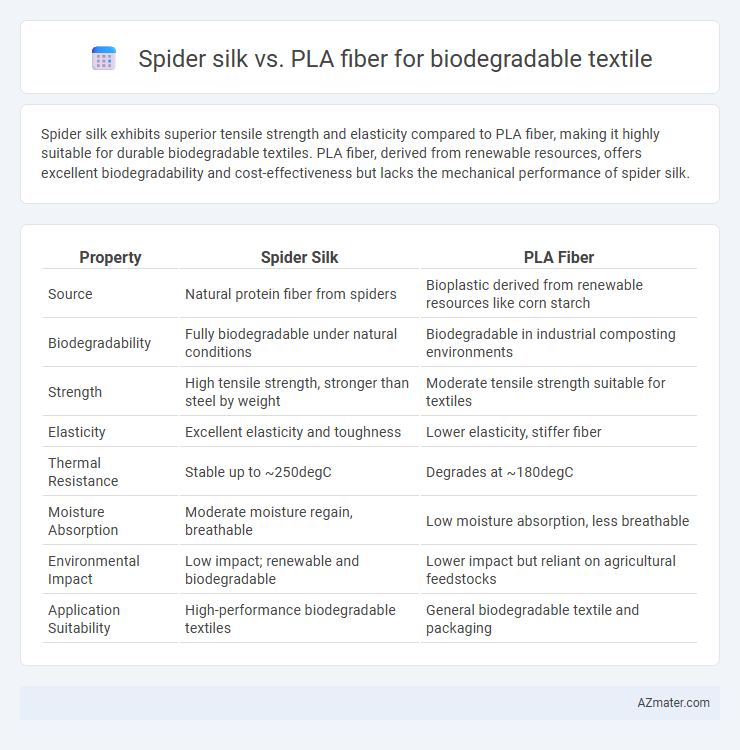Spider silk exhibits superior tensile strength and elasticity compared to PLA fiber, making it highly suitable for durable biodegradable textiles. PLA fiber, derived from renewable resources, offers excellent biodegradability and cost-effectiveness but lacks the mechanical performance of spider silk.
Table of Comparison
| Property | Spider Silk | PLA Fiber |
|---|---|---|
| Source | Natural protein fiber from spiders | Bioplastic derived from renewable resources like corn starch |
| Biodegradability | Fully biodegradable under natural conditions | Biodegradable in industrial composting environments |
| Strength | High tensile strength, stronger than steel by weight | Moderate tensile strength suitable for textiles |
| Elasticity | Excellent elasticity and toughness | Lower elasticity, stiffer fiber |
| Thermal Resistance | Stable up to ~250degC | Degrades at ~180degC |
| Moisture Absorption | Moderate moisture regain, breathable | Low moisture absorption, less breathable |
| Environmental Impact | Low impact; renewable and biodegradable | Lower impact but reliant on agricultural feedstocks |
| Application Suitability | High-performance biodegradable textiles | General biodegradable textile and packaging |
Introduction to Biodegradable Textiles
Biodegradable textiles are designed to break down naturally through microbial activity, reducing environmental impact compared to synthetic fibers. Spider silk offers exceptional strength, elasticity, and biodegradability, making it a promising alternative to traditional fibers like PLA (polylactic acid), which is derived from renewable resources such as corn starch but may degrade slower under certain conditions. The integration of spider silk and PLA fibers in biodegradable textiles supports sustainable fashion by combining durability, compostability, and lower carbon footprint.
Spider Silk: Nature’s Super Fiber
Spider silk, renowned for its exceptional tensile strength and elasticity, outperforms PLA fiber in biodegradability and environmental compatibility, making it a superior choice for sustainable textiles. Its protein-based composition allows complete decomposition without toxic residues, contrasting with PLA's slower degradation in industrial composting conditions. Advances in recombinant DNA technology have enabled scalable spider silk production, positioning it as a breakthrough material for eco-friendly, high-performance biodegradable textiles.
PLA Fiber: Plant-Based Innovation
PLA fiber, derived from renewable plant sources like corn starch, offers a sustainable alternative for biodegradable textiles due to its compostability and low carbon footprint. Its thermoplastic properties enable easy processing into fibers with excellent tensile strength, making it suitable for eco-friendly fashion and technical fabrics. Compared to spider silk, PLA fiber benefits from scalable production and cost-effectiveness, supporting widespread adoption in sustainable textile manufacturing.
Mechanical Properties: Strength and Flexibility
Spider silk exhibits superior tensile strength and exceptional elasticity compared to PLA fiber, making it highly resilient under mechanical stress while maintaining flexibility. PLA fiber, derived from renewable resources, provides moderate strength but tends to be more brittle and less flexible, limiting its durability in dynamic textile applications. The unique protein structure of spider silk enables repeated stretching without permanent deformation, whereas PLA's polymer chains are prone to fracturing under high strain.
Biodegradability and Environmental Impact
Spider silk exhibits superior biodegradability compared to PLA fiber, breaking down naturally within months without releasing harmful residues, making it an environmentally sustainable choice for textiles. PLA fiber, derived from renewable resources like corn starch, biodegrades under industrial composting conditions but can persist longer in natural environments, potentially contributing to microplastic pollution. The environmental impact of spider silk is minimized due to its natural production process and compostable end-of-life, whereas PLA fiber's ecological footprint is influenced by agricultural inputs and industrial processing requirements.
Production Methods and Scalability
Spider silk production relies on genetic engineering of microorganisms or transgenic animals to produce recombinant silk proteins, which are then spun into fibers through biomimetic spinning techniques, offering high tensile strength and elasticity. PLA fiber is synthesized from renewable resources like corn starch through polymerization and processed via conventional textile manufacturing methods such as melt spinning, enabling cost-effective mass production. Scalability challenges for spider silk include complex protein expression and fiber spinning processes limiting large-scale output, whereas PLA fibers benefit from established industrial infrastructure supporting high-volume, biodegradable textile production.
Cost Efficiency and Commercialization
Spider silk offers superior mechanical properties and biodegradability but remains costly due to complex synthetic production and low yield scalability. PLA fiber, derived from renewable resources like corn starch, provides a more cost-efficient and commercially viable option with established manufacturing processes and widespread market acceptance. Cost efficiency of PLA supports large-scale textile applications, while spider silk's commercialization is limited by high production expenses and technical challenges in mass fabrication.
Applications in Textile Industry
Spider silk exhibits exceptional tensile strength and elasticity, making it ideal for high-performance biodegradable textiles such as sportswear and medical sutures. PLA fiber, derived from renewable resources like corn starch, offers excellent biodegradability and ease of processing, widely used in eco-friendly fashion and disposable nonwovens. Both fibers contribute to sustainable textile innovation by reducing environmental impact and enhancing product lifecycle in the industry.
Challenges and Future Prospects
Spider silk offers exceptional mechanical strength and biodegradability, but its large-scale production faces challenges due to complex protein synthesis and low yield. PLA fiber, derived from renewable resources, provides a more scalable and cost-effective alternative, though it shows limitations in durability and moisture sensitivity. Advancements in genetic engineering and composite material development hold promise for overcoming current drawbacks, potentially enabling more sustainable and high-performance biodegradable textiles.
Conclusion: Spider Silk vs PLA Fiber
Spider silk exhibits superior tensile strength, elasticity, and biodegradability compared to PLA fiber, making it highly suitable for durable and eco-friendly textiles. PLA fiber offers cost-effective production and versatility but lags behind in mechanical performance and environmental degradation rate. Combining the strengths of spider silk's natural resilience with PLA's scalability could advance sustainable textile innovation.

Infographic: Spider silk vs PLA fiber for Biodegradable textile
 azmater.com
azmater.com